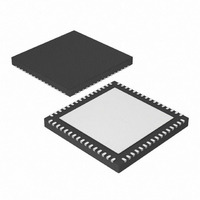DSPIC33FJ128GP706A-I/MR Microchip Technology, DSPIC33FJ128GP706A-I/MR Datasheet - Page 87

DSPIC33FJ128GP706A-I/MR
Manufacturer Part Number
DSPIC33FJ128GP706A-I/MR
Description
IC DSPIC MCU/DSP 128K 64-QFN
Manufacturer
Microchip Technology
Series
dsPIC™ 33Fr
Datasheets
1.MCP3909T-ISS.pdf
(104 pages)
2.DSPIC33FJ12GP201-ISO.pdf
(90 pages)
3.DSPIC33FJ64GP206-IPT.pdf
(28 pages)
4.DSPIC33FJ64GP206A-IMR.pdf
(338 pages)
Specifications of DSPIC33FJ128GP706A-I/MR
Core Processor
dsPIC
Core Size
16-Bit
Speed
40 MIPs
Connectivity
CAN, I²C, IrDA, LIN, SPI, UART/USART
Peripherals
AC'97, Brown-out Detect/Reset, DMA, I²S, POR, PWM, WDT
Number Of I /o
53
Program Memory Size
128KB (128K x 8)
Program Memory Type
FLASH
Ram Size
16K x 8
Voltage - Supply (vcc/vdd)
3 V ~ 3.6 V
Data Converters
A/D 18x10b/12b
Oscillator Type
Internal
Operating Temperature
-40°C ~ 85°C
Package / Case
64-VFQFN, Exposed Pad
Product
DSCs
Processor Series
DSPIC33F
Core
dsPIC
3rd Party Development Tools
52713-733, 52714-737, 53276-922, EWDSPIC
Development Tools By Supplier
PG164130, DV164035, DV244005, DV164005, PG164120, DM240001, DV164033
Core Frequency
40MHz
Core Supply Voltage
3.3V
Embedded Interface Type
I2C, SPI, UART
No. Of I/o's
53
Flash Memory Size
128KB
Supply Voltage Range
3V To 3.6V
Rohs Compliant
No
Lead Free Status / RoHS Status
Lead free / RoHS Compliant
Eeprom Size
-
Lead Free Status / Rohs Status
Lead free / RoHS Compliant
C.5
© 2009 Microchip Technology Inc.
MEASURING FREQUENCY
There are many ways to measure frequency, with the most common being counting the
signal cycle. In this method, a counter increments each time a zero-crossing is
detected. Based on the counts, the width of a cycle can be measured. If the zero-cross-
ing is accurate and the counter precision is high enough, cycle counting can be a
simple and practical method. But if the input signal has large harmonic components,
causing distortion around zero-crossing, then this approach may produce large errors.
Another method is to analyze and process the sampled data and calculate the frequen-
cies. Analysis may be carried out in time domain, such as digital differential ND and
interpolation method; or may be carried out in frequency domain after DFT transforma-
tion, such as gravity center method, spectrum zoom method and phase difference
method, among which the phase difference method is the most common one. It is not
sensitive to signal distortion around zero-crossing points.
The basic idea of the phase difference method is: if the rough range of to-be-measured
signal frequency is known, then we may assume a frequency that is close to the actual
frequency and then acquire an array of samples based on the assumed frequency. In
the sampled data, the phase of the 1st cycle and the subsequent N-th cycle are meau-
red and their difference may be calculated. Then the phase difference may be used to
calculate the difference between the actual freqency and the assumed frequence, thus
figuring out the actual frequency.
If the frequency f
Δf << f, then from Equation C-27, the fundamental signal can be expressed as:
EQUATION C-45:
If:
EQUATION C-46:
EQUATION C-47:
EQUATION C-48:
0
to be measured is known to be a definite value f, i.e., f
U
1
t ( )
u
u
a
b
=
=
=
=
=
u
-- -
T
2
2
-- -
T
c1
-- -
T
2
2
-- -
T
⋅
⋅
⋅
sin
⋅
T
∫
0
T
∫
0
T
∫
0
T
∫
0
U
U
u
u
(
c1
1
c1
1
ω
Power Calculation Theory
t ( )
t ( )
sin
sin
⋅
t
cos
sin
+
(
(
2
T
2
(
ϕ
(
π
π
ω
ω
u1
=
f
f
0
t
0
t
t
)
t
)
)
1
-- -
t d
f
t d
+
+
=
ϕ
ϕ
u
u1
u1
c1
)
)
cos
sin
sin
(
(
(
2
2
2
π
π
π
f
ft
ft
0
)
t
)
t d
t d
+
ϕ
u1
)
DS51723A-page 87
0
= f + Δf,











